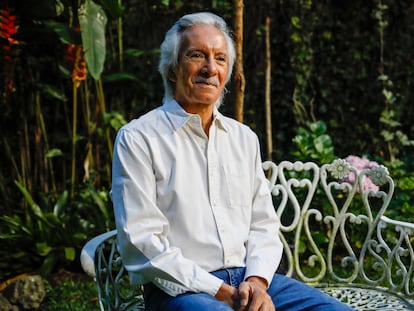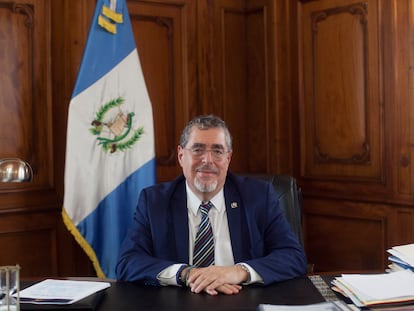Stolen children return to Guatemala to learn the truth
Around 30,000 children from the Central American country were given up for international adoption between 1977 and 2007. In many cases, the processes were riddled with irregularities and corruption. Some of the children, now grown up, have returned and are helping other people find their biological families
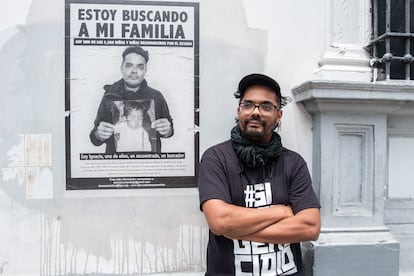
On the football field in Futeca Cayalá, an upscale neighbourhood in Guatemala City, a billboard displays motivational slogans: “Until the last drop. Sweating is glory. Leave it all on the field.” Osmín Ricardo Tobar Ramírez, the 35-year-old defensive captain and linebacker for Los Toros and Guatemala’s American football team, seems to take each of these words seriously. Wearing a helmet, shoulder pads and knee pads, he works hard at training, while his mother, Flor de María Ramírez Escobar, 52, watches him from the sidelines with a smile that lights up her face. She has spent 14 years of her life without seeing her son. Today, she takes advantage of every moment.
Tobar has been involved in sports ever since he was young. During his adolescence in Pittsburgh, Pennsylvania, he won a university wrestling scholarship. Physical activity is his escape valve, a way of “finding balance” in an existence filled with ups and downs.
Today, he works in a telemarketing company in Guatemala, thanks to his perfect English. He lives with his wife Lilian and his son, Cristian. “With the life I’ve led, I never imagined I could have a stable home. It’s been a great plot twist,” Tobar confesses to EL PAÍS. While he speaks in Spanish, English words sometimes slip in.
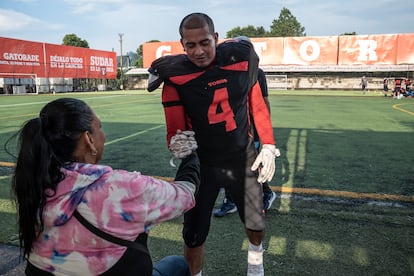
More than 3,000 miles away from this field, in Montreal, Canada, Ignacio “Nacho” Alvarado dreams of a new bicycle for his next project: pedaling from Mexico City to Guatemala City, to draw attention to his cause. “We want to raise awareness so that what happened to us doesn’t happen again,” he explains with determination.
Alvarado and Tobar have a lot in common. They are two of the 30,000 Guatemalan children given up for international adoption between 1977 and 2007. Much of these processes were marked by irregularities and corruption, according to the Inter-American Court of Human Rights (IACHR). In 2018, the judicial body condemned the Central American state for the case of Tobar and his brother.
Tobar was adopted in the United States in 1998, while Alvarado was adopted in Canada in the 1980s. As adults, they’ve returned to Guatemala to learn the truth about their adoptions and to reunite with their biological families. Both are also human rights activists and are speaking up to ensure that the “legalized” theft of children in Guatemala isn’t forgotten.
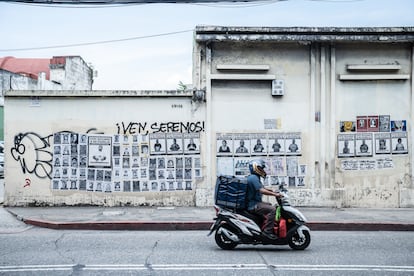
That cursed day
“I will never forget January 9, 1997,” Tobar sighs. He was seven years old and officials from the Attorney General’s Office entered his house and took him and his brother, after a complaint was filed by a neighbor, stating that the children had been abandoned. “They told me that they would return us in the afternoon… but that was the last time I saw my house,” he remembers.
At that time, Ramírez — who was raising Tobar and J.R. alone (the initials used by the court to protect the brother’s identity, since he prefers not to be involved in the process regarding his origins) — was at work. In fact, she was employed by a government agency linked to the Tax Administration. “I was happy, because I was earning 2,000 quetzales ($250 a month) and could give my children a good life. When I found out what had happened, I lost control and tore up half of the money, out of desperation for not knowing where they were,” she recalls.
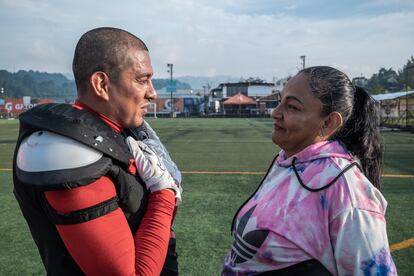
Ramírez went to the Juvenile Court, where it was confirmed that her children had been taken away. From there, a quick trial began. A judge ultimately declared that she was unfit to care for them. The children — admitted to the Los Niños de Guatemala association — were declared “abandoned.”
“I never saw them again. I felt like a ship without a rudder. I was dead in life,” Ramírez remembers. Tears stream down her face 27 years later.
In April 1998, a rapid adoption process was opened for the two brothers, who were separated. Each was adopted by a different family. Tobar flew to Pittsburgh on June 2 of that year, already under a different name. Appeals were filed to review the sentence by Ramírez and, later, by Gustavo Tobar Fajardo — the biological father of the children — who had migrated to Mexico for economic reasons. The legal attempts were of no use.
“I was beaten and abused in the [orphanages]. I also thought I had lost my brother. When I was adopted, I was happy to leave… but I never connected with my adoptive parents and my life in the United States was unhappy,” Tobar admits. He spent his life feeling uprooted. “I tried to escape from life. I drank, smoked, joined a gang, and even spent a few months in jail.”
Unlike Tobar, Ignacio Alvarado — abandoned at birth — was found by residents in a community in the east of the country, who cared for him with love and took him to the hospital for medical checkups. Shortly afterwards, he disappeared. It was later discovered that he had been transferred to the Elisa Martínez orphanage, exposed years later for its involvement in child-trafficking. “The residents were so sad that they started calling the river in the community ‘The Return of the Child,’ hoping that, one day, I would come back,” Alvarado says.
At the age of three, he was adopted by a Canadian family. By the age of 17, he had already changed families three times. His life was as hard as Tobar’s. “As an adult, a friend showed me an article about child-trafficking in the orphanage where I had come from. I asked myself: ‘Did this happen to me?’”
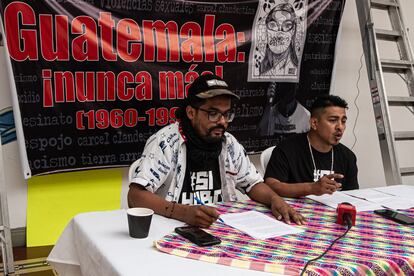
The market for children
Tobar and Alvarado were adopted in the context of the internal armed conflict, which left at least 200,000 dead and missing in Guatemala between 1960 and 1996. Amid the institutional chaos, in 1977, Guatemala approved a law that allowed notaries and lawyers to manage adoptions without judicial authorization. This favored the creation of child-trafficking networks. Hospitals, the army, judicial bodies and orphanages were involved.
Many notaries enriched themselves by facilitating international adoptions, without first investigating whether a child was actually orphaned or abandoned, or whether the family that was going to receive them was suitable. They often took advantage of people’s poverty: adoptive families could end up paying between $30,000 and $80,000, according to calculations made by experts consulted by the IACHR. “An amount [of money] that could have been used to support families in Guatemala, without removing the children from their homes,” Tobar and Alvarado note.
These legal facilities made Guatemala one of the four countries that gave up the largest number of children for adoption in the world, according to a report by the United Nations Special Rapporteur. And, in 2008, the majority of the children who arrived in the United States to be adopted were of Guatemalan origin, despite the fact that the Guatemalan Adoption Law of 2007 established international adoption as a last resort. In 2010, the International Commission against Impunity in Guatemala (CICIG) concluded that human trafficking networks used various strategies to obtain children, from threatening mothers to engaging in so-called “child-laundering,” which consisted of presenting stolen or supposedly abandoned children before a judge to declare them suitable for adoption.
Tobar and his family were victims of this child-laundering. Alvarado was not, but the two were “sold to families who were dying to have a child,” Alvarado explains.
Returning to Guatemala
With the legal support of organizations such as Casa Alianza (now La Alianza, or “The Alliance”) and later El Refugio de la Niñez (“The Children’s Refuge”), Gustavo Tobar fought all his life to regain his parental rights, track down his son, and speak out against the theft of children. In 2002, a journalist from Newsweek located Tobar and showed him photos of his biological parents. “I cried and wanted to go back,” he says. But he was only a 12-year-old boy at the time.
“When they told me that my son was alive, I had hope again,” Gustavo Tobar recalls, his voice breaking with emotion. The story took a turn in 2009, when the father contacted his son on Facebook. In 2011, they finally met again. And, in 2015, Osmín Tobar decided to return to Guatemala permanently.
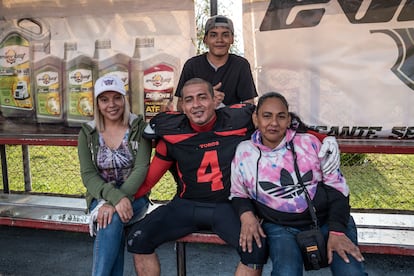
Thanks to Gustavo Tobar, the case of his children reached the Inter-American Court of Human Rights. In 2018, the judicial body condemned the state of Guatemala for the irregular adoption of the brothers. According to the ruling, these adoptions “took place within a framework of corruption, in which a group of public and private actors and institutions operated under the guise of protecting the best interests of the child, but with the real purpose of achieving their own enrichment.” In July of 2024, Bernardo Arévalo became the first president to formally apologize on behalf of the Guatemalan state.
“For the first time, I felt that my life had meaning. I stopped drinking, because I was a public figure and had the responsibility of representing illegally adopted people,” Tobar emphasizes.
For his part, Alvarado began to investigate his origins during a trip to Guatemala in 2019. “Walking down Sixth Avenue, I saw the photos of those who disappeared during the conflict. I got the idea of putting up posters of myself, to see if anyone was looking for me,” Alvarado tells EL PAÍS. With the support of the non-profit organization HIJOS Guatemala, he managed to place his photo in several spots, to raise awareness about child-trafficking.
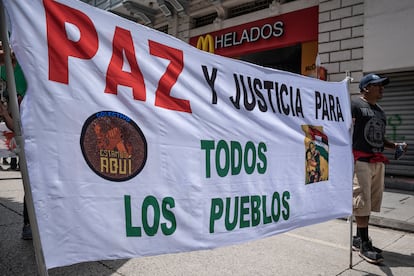
A DNA sample allowed him to contact a second cousin. Little by little, he learned that his origins were in a community in the east of the country. And, in 2022, he was able to meet his mother with the support of the Mental Health League of Guatemala. “It was a very powerful feeling… but you don’t have to romanticize it. You can’t get back 35 years: it’s like being adopted for a second time. It takes time to build a relationship,” Alvarado acknowledges.
In 2021, he founded the Estamos Aquí collective. Tobar is also a member. Any adopted person who has doubts about their past or is looking for their biological family can contact them. To do so, the organization uses DNA samples, birth certificates, or puts up photographs in the streets. In three years, they’ve achieved eight reunions. “It’s important that biological parents don’t blame themselves, even though it may be difficult,” Alvarado emphasizes.
He’s about to end the video call with EL PAÍS, when he suddenly remembers that he has forgotten to mention something important: “You know what? In the community where they found me, they’ve already changed the name of the river. Now, it’s called ‘The Boy Returned,’ because I’ve come back,” he laughs, smiling in his French-accented Spanish.
Translated by Avik Jain Chatlani.
Sign up for our weekly newsletter to get more English-language news coverage from EL PAÍS USA Edition
Tu suscripción se está usando en otro dispositivo
¿Quieres añadir otro usuario a tu suscripción?
Si continúas leyendo en este dispositivo, no se podrá leer en el otro.
FlechaTu suscripción se está usando en otro dispositivo y solo puedes acceder a EL PAÍS desde un dispositivo a la vez.
Si quieres compartir tu cuenta, cambia tu suscripción a la modalidad Premium, así podrás añadir otro usuario. Cada uno accederá con su propia cuenta de email, lo que os permitirá personalizar vuestra experiencia en EL PAÍS.
¿Tienes una suscripción de empresa? Accede aquí para contratar más cuentas.
En el caso de no saber quién está usando tu cuenta, te recomendamos cambiar tu contraseña aquí.
Si decides continuar compartiendo tu cuenta, este mensaje se mostrará en tu dispositivo y en el de la otra persona que está usando tu cuenta de forma indefinida, afectando a tu experiencia de lectura. Puedes consultar aquí los términos y condiciones de la suscripción digital.
More information
Archived In
Últimas noticias
Most viewed
- Reinhard Genzel, Nobel laureate in physics: ‘One-minute videos will never give you the truth’
- Pablo Escobar’s hippos: A serious environmental problem, 40 years on
- Charles Dubouloz, mountaineering star, retires at 36 with a farewell tour inspired by Walter Bonatti
- Why we lost the habit of sleeping in two segments and how that changed our sense of time
- The fall of a prolific science journal exposes the billion-dollar profits of scientific publishing
